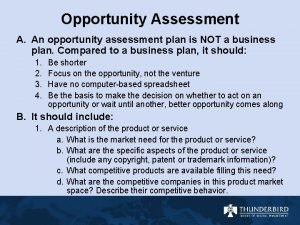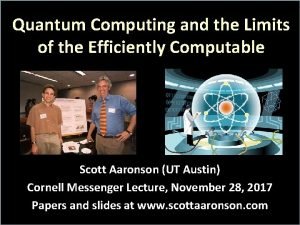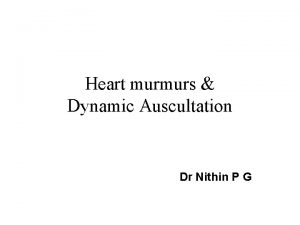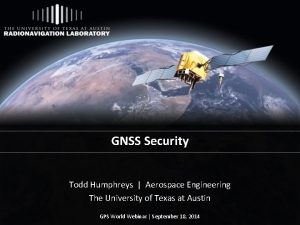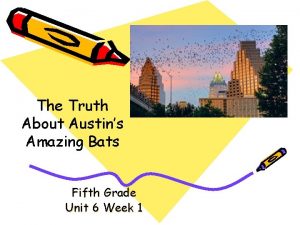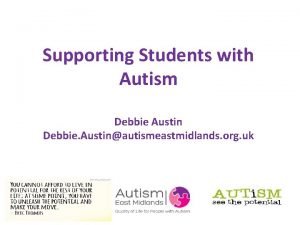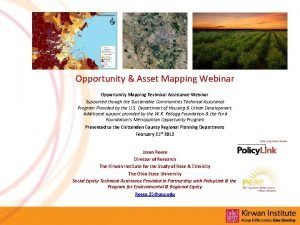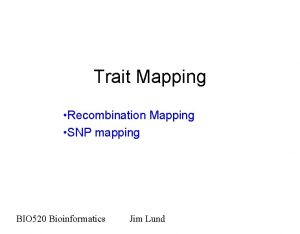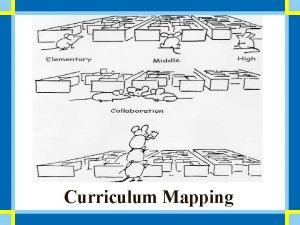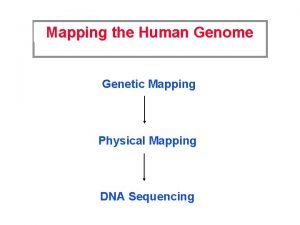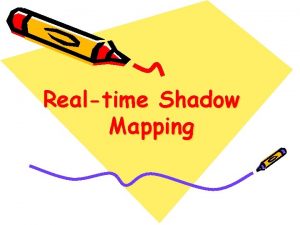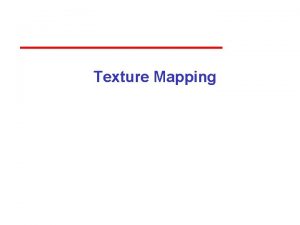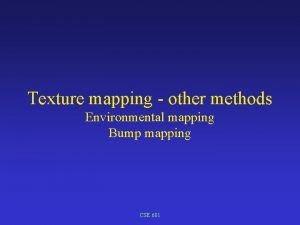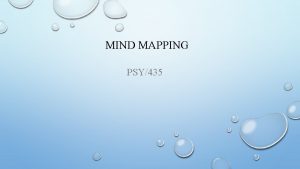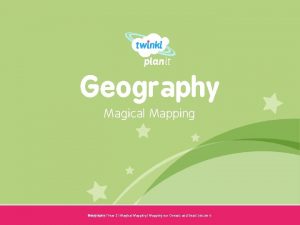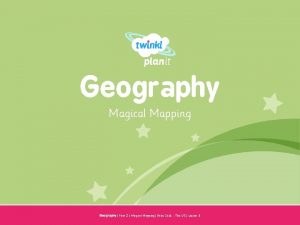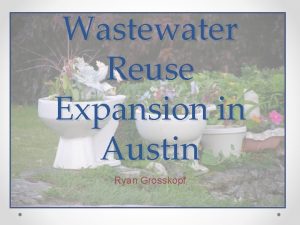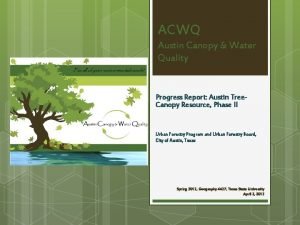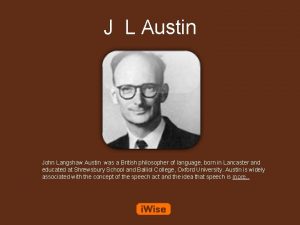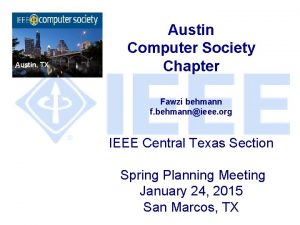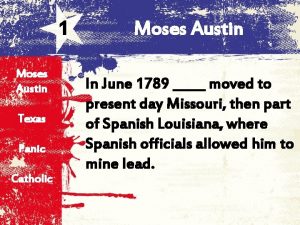The Geography of Opportunity in Austin Mapping Opportunity

























































- Slides: 57

The Geography of Opportunity in Austin: Mapping Opportunity to Support a Vibrant Region March 21 st 2007 john a. powell Williams Chair in Civil Rights & Civil Liberties, Moritz College of Law Executive Director, Kirwan Institute for the Study of Race and Ethnicity The Ohio State University http: //www. kirwaninstitute. org/

Today’s Presentation ► What is the Community of Opportunity approach to community development? ► What is opportunity mapping? How has opportunity mapping been used before? ► The geography of opportunity in Austin ► How can we use this information? 2

► What is the “Community of Opportunity” Model? 3

Place and Life Outcomes ► Where you live is more important than what you live in… Housing -- in particular its location -- is the primary mechanism for accessing opportunity in our society Housing location determines the quality of schools children attend, the quality of public services they receive, access to employment and transportation, exposure to health risks, access to health care, etc. For those living in high poverty neighborhoods, these factors can significantly inhibit life outcomes 4

Housing and Opportunity Housing is Critical in Determining Access to Opportunity Health Childcare Employment Housing Effective Education Participation Transportation 5

Communities of Opportunity ► The “Communities of Opportunity” framework is a model of fair housing and community development ► The model is based on the premises that Everyone should have fair access to the critical opportunity structures needed to succeed in life Affirmatively connecting people to opportunity creates positive, transformative change in communities 6

Communities of Opportunity ► The “Communities of Opportunity” model advocates for a fair investment in all of a region’s people and neighborhoods -- to improve the life outcomes of all citizens, and to improve the health of the entire region A focus on people, investing in our residents (and their communities) to produce transformative change 7

The Web of Opportunity ► Opportunities in our society are geographically distributed (and often clustered) throughout metropolitan areas This creates “winner” and “loser” communities or “high” and “low” opportunity communities ► Your location within this “web of opportunity” plays a decisive role in your life potential and outcomes Individual characteristics still matter… …but so does access to opportunity, such as good schools, health care, child care, and job networks 8

The Cumulative Impacts of Racial and Opportunity Segregation impacts a number of life-opportunities Impacts on Health School Segregation Impacts on Educational Achievement Exposure to crime; arrest Transportation limitations and other inequitable public services Neighborhood Segregation Job segregation Racial stigma, other psychological impacts Impacts on community power and individual assets 9 Adapted from figure by Barbara Reskin at: http: //faculty. washington. edu/reskin/

Economic Conditions High Opportunity Low Opportunity 10

School Conditions High Opportunity Low Opportunity 11

► What is Opportunity Mapping? ► How has it been used before? 12

The Geography of Opportunity ► The Communities of Opportunity framework is inherently spatial Inequality has a geographic footprint Maps can visually track the history and presence of discriminatory and exclusionary policies This “opportunity mapping” has been completed for many metropolitan areas in the U. S. and is used by advocates to further fair housing and community development goals ► The Communities of Opportunity model uses state-of-theart geographic information systems (GIS) and extensive data sets to analyze the distribution of opportunity in our metropolitan areas 13

Opportunity Mapping ► Opportunity mapping is a research tool used to understand the dynamics of “opportunity” within metropolitan areas ► The purpose of opportunity mapping is to illustrate where opportunity rich communities exist (and assess who has access to these communities) Also, to understand what needs to be remedied in opportunity poor communities 14

General Methodology ► Opportunity mapping methodology Requires a comprehensive assessment of local indicators related to opportunity ► Economic conditions, education, neighborhood health etc. Would be extremely difficult without Geographic Information Systems technology Analyzing multiple opportunity indicators to create a comprehensive opportunity index ► Break Census Tracts into quintiles (based on opportunity index score) to distinguish between various opportunity categories (very low, moderate, high, very high) 15

Similar Models Used Elsewhere ► The concept of using neighborhood based data to assess neighborhood opportunities and challenges is not unprecedented and is used in various sectors (examples) Business: Site selection analysis by firms such as Claritas Community Development: Criteria used to identify areas for targeted investment or areas targeted for specific community development initiatives Housing: Models that try to connect affordable housing to areas of job growth “work force housing initiatives” ► The use of neighborhood based indicators for measuring sustainability is well established in the Austin region Opportunity mapping adds an additional analytical lens to this significant body of existing work in the region 16

What has opportunity mapping been used for in other regions? ► The Kirwan Institute has conducted opportunity mapping in approximately a dozen metropolitan regions, some prominent examples of this work informing action can be found in three regions Chicago Baltimore Cleveland 17

Chicago: The Kirwan Institute worked with the Leadership Council for Metropolitan Open Communities and the Institute of Race and Poverty to conduct an opportunity mapping analysis in the Chicago region ► The opportunity maps produced as part of the Chicago research were utilized by the Leadership Council for advising inner-city voucher holders looking to relocate to higher opportunity neighborhoods in Chicago ► In addition, the research was utilized to inform inclusionary housing advocacy in the Chicago region, focusing on inclusionary zoning advocacy and to assess the impacts of the Low Income Housing Tax Credit program on expanding access to opportunity in the Chicago region ► 18

Chicago’s Communities of Opportunity ► This example is a 6 county Communities of Opportunity map for the Chicago region Red = Lowest Opportunity Blue = Highest Opportunity Source: Report published by the Leadership Council for Metropolitan Open Communities 2005 19

Baltimore (Litigation) Baltimore: Opportunity mapping in the Baltimore region was conducted as part of the Thompson v. HUD fair housing litigation ► Plaintiffs used opportunity mapping to frame their remedial proposal, in response to a liability ruling that found the U. S. Department of Housing and Urban Development in violation of the Fair Housing Act ► The plaintiffs have proposed establishing 7, 000 affordable housing units in the region’s high- opportunity communities, available to volunteers who wish to relocate out of the City of Baltimore’s public housing ► 20

Proposed remedy identifies Communities of Opportunity ► Used 14 indicators of neighborhood opportunity to designate high and low opportunity neighborhoods in the region Neighborhood Quality/Health ► Poverty, Crime, Vacancy, Property Values, Population Trends Economic Opportunity ► Proximity to Jobs and Job Changes, Public Transit Educational Opportunity ► School Poverty, School Test Scores, Teacher Qualifications 21

Baltimore (Community Organizing) ► Baltimore: In response to the proposed remedy, an umbrella organization of seven social justice organizations (known as the Baltimore Regional Housing Campaign) has adopted the opportunity-based approach and is actively working outside of the Court’s remedial action to develop affordable housing options in Baltimore’s high-opportunity communities, as well as counseling those who desire to leave Baltimore’s public housing for new opportunities 22

Cleveland ► Cleveland: Opportunity mapping and GIS analysis were used in the Cleveland region to assess economic opportunities in the region, in relation to Minority Business concentrations Most MBE's in the region were clustered in neighborhoods with declining economic opportunity, producing potential impediments to business networking and access to markets ► Additional opportunity analysis was used to inform regional growth and development policy recommendations formulated by the Presidents’ Council of Cleveland, a committee of leading political, civic and business leaders in the African American community 23

Cleveland opportunity analysis & race 24

► The geography of opportunity in the Austin region 25

Background on the Austin Initiative The Central Texas Opportunity initiative was initiated by Community Partnership for the Homeless and involved a steering committee representing a diverse array of organizations in the Central Texas region ► The committee included representatives from ► People. Fund, a regional community development financial institution; Envision Central Texas, a regional planning body; Capital Metro, the region’s public transit authority; the Indigent Care Collaborative, a nonprofit health organization focused on public health issues for the poor; Capitol Area Council of Governments; United Way Capital Area; Habitat for Humanity; and several professors from the University of Texas’ Community & Regional Planning and Public Health Departments ► The broader goal of the opportunity mapping initiative is to provide a data resource for policy makers, community development practitioners, social service providers, and the public to support actions to remedy socioeconomic inequity issues highlighted by the map, such as providing access to health care or addressing affordable housing 26

Selecting Indicators of Opportunity ► The committee worked collaboratively with the Kirwan Institute to identify indicators of opportunity in the region ► The selection of indicators was based on input regarding issues or concerns in the region, as well as research literature validating the connection between indicators and opportunity Twenty-two indicator areas were selected for the analysis, covering education, economic conditions, mobility and transportation, public health and the environment, and neighborhood quality 27

Indicators of Opportunity: Austin 28

General Results ► The Comprehensive Opportunity Map (which represents all opportunity indicators) As seen in the following maps, higher opportunity areas in the region are primarily concentrated west of I 35, with the highest opportunity communities found directly west of I-35 in the Travis County area The lowest opportunity areas are primarily concentrated in southeastern Travis County and in the region’s eastern counties (Caldwell and Bastrop) The largest concentration of high-opportunity communities are found in the portions of the City of Austin west of I-35 and most of the suburban communities adjacent to Austin west of I-35 29

How is Opportunity Distributed in a Hot Market City? (Austin, TX) Opportunity in the Austin region is more centralized (not a hollow region like Cleveland or Baltimore). Although, opportunity is more centralized it is still spatially segregated. 30

An in-depth view of the distribution of high and low opportunity areas in and around the City of Austin 31

Other Opportunity Maps: Education ► The east-west divide along I-35 is evident in educational conditions in the region, with all high-opportunity areas found west of I-35 ► Areas of low educational opportunity are concentrated east of I-35, but centered around Travis County ► Most areas in Caldwell and Bastrop Counties scored as “moderate” areas of educational opportunity 32

Education Opportunity Map (based on educational indicators for elementary schools) 33

Other Opportunity Maps: Housing and Neighborhood Quality The distribution of high and low opportunity census tracts based on the housing and neighborhood quality analysis is seen in the following map The highest opportunity areas in the neighborhood analysis are located west of I-35, spreading from Hays to Williamson County Most of the high-opportunity tracts in Travis County are west of Route 183 The lowest opportunity tracts in this analysis are located in the center of Travis County, directly east of I-35 34

Neighborhood Conditions “Quality” Opportunity Map (based on neighborhood quality indicators for census tracts) 35

Other Opportunity Maps ► Economic Opportunity Economic opportunities in the region are generally centralized, but are more concentrated to the west of I-35 ► Opportunity related to Transportation Mobility-related opportunity in the region is highly concentrated, reflecting the centralized nature of the public transportation system and lower commute times for urban workers (also related to the general concentration of jobs near the City of Austin) ► Public Health and Environmental Quality The highest performing areas in the region are concentrated west of I-35, including parts of western Travis County and portions of Williamson County 36

37

Public Health and Environmental Quality Opportunity Map (based on indicators of public health and environmental quality) 38

► How can we use this analysis and information? 39

Using this Information to Produce Action (Some Examples) ► Assess and work to remedy racial, ethnic, economic segregation from opportunity in the region ► Look at affordable housing and access to high opportunity areas ► Exploring linkages with the opportunity mapping data (e. g. public transit and health care facilities) 40

Opportunity Segregation ► Just like a weak market city, hot markets can result in segregation from communities of opportunity for marginalized groups In weak market regions (Detroit) people are disconnected from high opportunity neighborhoods in the suburbs In hot market regions (Austin) people may be disconnected from high opportunity neighborhoods in the city 41

Opportunity Segregation in Austin ► Latino and African American populations are concentrated in the region’s low and moderate opportunity communities While 39% of Whites in the region are in very low- or lowopportunity census tracts, 60% of Latinos and African Americans are concentrated in these tracts Linguistically isolated populations are also more likely to be concentrated in low-opportunity areas, with 56% of all linguistically isolated people located in very low or low opportunity census tracts Latino and African American children are much more likely to be located in the region’s low opportunity areas, with 2 out of 3 African American and Latino children found in these communities For children in poverty, this isolation from opportunity is more pronounced, with 69% of children in poverty in the region found in the region’s low-opportunity census tracts 42

Segregation from Opportunity 43

Linguistically Isolated People and the Comprehensive Opportunity Map for the Austin Region 44

Children of Color and Educational Opportunity 45

Remedying Opportunity Segregation ► To remedy such “opportunity segregation, ” the Communities of Opportunity approach emphasizes investment in ► People ► Places ► Linkages 46

Examples ► People Subsidies for affordable housing in high-opportunity neighborhoods with good schools ► Although inclusionary zoning is not permitted in Texas, other inclusionary models could be explored (e. g. developer incentives for production of affordable units) Promoting school mobility Wealth building programs for residents in low opportunity areas ► Places Regional housing and neighborhood development plans Opportunity-based Zoning Targeted investment in failing schools ► Linkages Improved public transportation to jobs and other critical opportunity 47 structures

Inclusion for Marginalized Communities in Hot Market Regions ► How can marginalized communities benefit more from the economic growth and investment found in hot market regions? ► Three strategies: Assure business investments provide benefits to disadvantaged groups (community benefits agreements) Assess the racial impacts of new developments (Racial Impact Statements) Assure people are prepared to be included in Austin’s thriving 21 st century economy (education) Focus on affordable housing opportunities in growing high opportunity areas 48

Opportunity and Subsidized Housing Subsidized housing is almost non existent in high opportunity areas ► Approximately 1 out of 10 subsidized housing sites can be found in high opportunity census tracts, while 2 out of 3 sites are concentrated in the region’s low opportunity areas ► 49

How can we counter this trend? ► Housing should be a primary policy concern (how do we connect affordable housing to high opportunity areas) Work to assure affordable housing is included in new investments Assure inclusionary housing requirement as part of developer incentives Work to maintain/preserve existing affordable units Promote alternative revenue streams for affordable housing (explore expanding resources for housing trust fund) 50

Using Opportunity Mapping Data to Explore Linkages ► Example: How is the region’s public transit infrastructure connected to the region’s health care facilities (clinics, physicians offices, hospitals) Public transit lines are well connected to public health resources in the City of Austin, but transit access gaps exist with regard to health care resources directly to the west and north of the City of Austin 51

52

Thinking Opportunistically ► Given this information, what can concerned stakeholders in the Austin region do to promote integration with opportunity? Be prepared to take advantage of the opportunities and resources for changing the regional arrangements which isolate residents from opportunity ► Educational reforms? ► Assuring marginalized residents benefit from transportation and public transit investments? ► Utilizing the regions rapid investment and building boom to promote inclusion and assuring community benefits? Prioritize and target specific initiatives as a starting point 53

Linked fates…transformative change Our fates are linked, yet our fates have been socially constructed as disconnected ► We need socially constructed “bridges” to transform our society Conceive of an individuality as connected to—instead of isolated from—“thy neighbor” Be advocates for “Communities of Opportunity” as transformative change ►Transformative : An intervention that works to permanently transform structural arrangements which produce inequity and disparity ► 54

Agents of transformative change ► Recognize that advocacy can be instrumental to connecting people to critical opportunity structures Education, Jobs, Child care, Health care, Transportation ► All of these are related and affect each other; all show effects of cumulative disparity; all are ripe for transformative change ► Creating the potential for healthier citizens, communities and a more vibrant region 55

Concluding Thoughts ►We need integration with opportunity to have a truly “just” society A society where all people would have access to the means essential to living a life they have reason to value A society where a geographic identifier would not predict an individual’s life chances Linked fate 56

Questions or Comments? For More Information Visit Us On-Line: www. Kirwan. Institute. org 57
 Prinsip analisis dan desain
Prinsip analisis dan desain The associative mapping is costlier than direct mapping.
The associative mapping is costlier than direct mapping. Forward mapping vs backward mapping
Forward mapping vs backward mapping An opportunity assessment plan:
An opportunity assessment plan: Proruption ap human geography
Proruption ap human geography Ap human geography frq examples
Ap human geography frq examples 5 themes of geography ap human geography
5 themes of geography ap human geography độ dài liên kết
độ dài liên kết Thiếu nhi thế giới liên hoan
Thiếu nhi thế giới liên hoan Khi nào hổ con có thể sống độc lập
Khi nào hổ con có thể sống độc lập Chúa yêu trần thế alleluia
Chúa yêu trần thế alleluia điện thế nghỉ
điện thế nghỉ Một số thể thơ truyền thống
Một số thể thơ truyền thống Trời xanh đây là của chúng ta thể thơ
Trời xanh đây là của chúng ta thể thơ Thế nào là số nguyên tố
Thế nào là số nguyên tố đặc điểm cơ thể của người tối cổ
đặc điểm cơ thể của người tối cổ Tỉ lệ cơ thể trẻ em
Tỉ lệ cơ thể trẻ em Vẽ hình chiếu vuông góc của vật thể sau
Vẽ hình chiếu vuông góc của vật thể sau Các châu lục và đại dương trên thế giới
Các châu lục và đại dương trên thế giới Thế nào là hệ số cao nhất
Thế nào là hệ số cao nhất ưu thế lai là gì
ưu thế lai là gì Sơ đồ cơ thể người
Sơ đồ cơ thể người Kể tên các môn thể thao
Kể tên các môn thể thao Tư thế ngồi viết
Tư thế ngồi viết Cái miệng bé xinh thế chỉ nói điều hay thôi
Cái miệng bé xinh thế chỉ nói điều hay thôi Hát kết hợp bộ gõ cơ thể
Hát kết hợp bộ gõ cơ thể Cách giải mật thư tọa độ
Cách giải mật thư tọa độ Tư thế ngồi viết
Tư thế ngồi viết Thẻ vin
Thẻ vin Gấu đi như thế nào
Gấu đi như thế nào Thể thơ truyền thống
Thể thơ truyền thống Các châu lục và đại dương trên thế giới
Các châu lục và đại dương trên thế giới Sự nuôi và dạy con của hươu
Sự nuôi và dạy con của hươu Từ ngữ thể hiện lòng nhân hậu
Từ ngữ thể hiện lòng nhân hậu Diễn thế sinh thái là
Diễn thế sinh thái là Vẽ hình chiếu vuông góc của vật thể sau
Vẽ hình chiếu vuông góc của vật thể sau Slidetodoc
Slidetodoc V cc cc
V cc cc Phép trừ bù
Phép trừ bù Lời thề hippocrates
Lời thề hippocrates Thang điểm glasgow
Thang điểm glasgow đại từ thay thế
đại từ thay thế Quá trình desamine hóa có thể tạo ra
Quá trình desamine hóa có thể tạo ra Công thức tiính động năng
Công thức tiính động năng Thế nào là mạng điện lắp đặt kiểu nổi
Thế nào là mạng điện lắp đặt kiểu nổi Các loại đột biến cấu trúc nhiễm sắc thể
Các loại đột biến cấu trúc nhiễm sắc thể Thế nào là sự mỏi cơ
Thế nào là sự mỏi cơ Bổ thể
Bổ thể Vẽ hình chiếu đứng bằng cạnh của vật thể
Vẽ hình chiếu đứng bằng cạnh của vật thể Ut austin quantum computing
Ut austin quantum computing Rics
Rics Todd humphreys
Todd humphreys Ayat alkitab tentang kesempurnaan
Ayat alkitab tentang kesempurnaan Mexican federal constitution of 1824
Mexican federal constitution of 1824 John austin mengenal ajaran analytical jurisprudence
John austin mengenal ajaran analytical jurisprudence Austin's amazing bats
Austin's amazing bats Debbie austin
Debbie austin Charles curry austin
Charles curry austin



